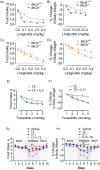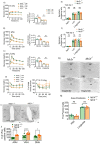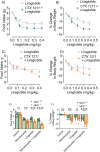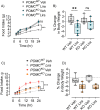This is a preprint.
Inhibition of the melanocortin-3 receptor (MC3R) causes generalized sensitization to anorectic agents
- PMID: 38106197
- PMCID: PMC10723368
- DOI: 10.1101/2023.12.05.570114
Inhibition of the melanocortin-3 receptor (MC3R) causes generalized sensitization to anorectic agents
Update in
-
Subthreshold activation of the melanocortin system causes generalized sensitization to anorectic agents in mice.J Clin Invest. 2024 Jul 15;134(14):e178250. doi: 10.1172/JCI178250. J Clin Invest. 2024. PMID: 39007271 Free PMC article.
Abstract
The melanocortin-3 receptor (MC3R) acts presynaptically to regulate GABA release from agouti-related protein (AgRP) nerve terminals and thus may be a negative regulator of multiple circuits involved in feeding behavior and energy homeostasis. Here, we examined the role of MC3R in regulating the response to various anorexigenic agents. Our findings reveal that genetic deletion or pharmacological inhibition of MC3R improves the dose responsiveness to Glucagon-like peptide 1 (GLP1) agonists, as assayed by inhibition of food intake and weight loss. An enhanced anorectic response to other agents, including the acute satiety factors peptide YY (PYY3-36) and cholecystokinin (CCK) and the long-term adipostatic factor, leptin, demonstrated that increased sensitivity to anorectic agents is a generalized result of MC3R antagonism. Enhanced neuronal activation in multiple nuclei, including ARH, VMH, and DMH, was observed using Fos immunohistochemistry following low-dose liraglutide in MC3R knockout mice (Mc3r-/-), supporting the hypothesis that the MC3R is a negative regulator of circuits regulating multiple aspects of feeding behavior. The enhanced anorectic response in Mc3r -/- mice after administration of GLP1 analogs was also independent of the incretin effects and malaise induced by GLP1R analogs, suggesting that MC3R antagonists may have value in enhancing the dose-response range of obesity therapeutics.
Conflict of interest statement
Conflict of Interest Statement: RDC, PS, SYW, TS, and the University of Michigan are shareholders in Courage Therapeutics. RDC, NSD, PS, and TS are on patents related to this work.
Figures






References
-
- Huszar D., Lynch C. A., Fairchild-Huntress V., Dunmore J. H., Fang Q., Berkemeier L. R., Gu W., Kesterson R. A., Boston B. A., Cone R. D., Smith F. J., Campfield L. A., Burn P., & Lee F. (1997). Targeted disruption of the melanocortin-4 receptor results in obesity in mice. Cell, 88(1), 131–141. - PubMed
-
- Yeo G. S., Farooqi I. S., Aminian S., Halsall D. J., Stanhope R. G., & O’Rahilly S. (1998). A frameshift mutation in MC4R associated with dominantly inherited human obesity. Nature genetics, 20(2), 111–112. - PubMed
-
- Vaisse C., Clement K., Guy-Grand B., & Froguel P. (1998). A frameshift mutation in human MC4R is associated with a dominant form of obesity. Nature genetics, 20(2), 113–114. - PubMed
-
- Butler A. A., Kesterson R. A., Khong K., Cullen M. J., Pelleymounter M. A., Dekoning J., Baetscher M., & Cone R. D. (2000). A unique metabolic syndrome causes obesity in the melanocortin-3 receptor-deficient mouse. Endocrinology, 141(9), 3518–3521. - PubMed
-
- Chen A. S., Marsh D. J., Trumbauer M. E., Frazier E. G., Guan X. M., Yu H., Rosenblum C. I., Vongs A., Feng Y., Cao L., Metzger J. M., Strack A. M., Camacho R. E., Mellin T. N., Nunes C. N., Min W., Fisher J., Gopal-Truter S., MacIntyre D. E., Chen H. Y., … Van der Ploeg L. H. (2000). Inactivation of the mouse melanocortin-3 receptor results in increased fat mass and reduced lean body mass. Nature genetics, 26(1), 97–102. - PubMed
Publication types
Grants and funding
LinkOut - more resources
Full Text Sources
Other Literature Sources
